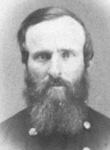 Open main menu
Open main menu
 Open main menu
Open main menu

R.B. Hayes
(1822 - 1893)
Home State: Ohio
Education: Kenyon College, Harvard Law
Command Billet: Commanding Regiment
Branch of Service: Infantry
Unit: 23rd Ohio Infantry
Before Antietam
He was a lawyer in Sandusky then Cincinnati, OH. At age 38 he enrolled on 7 June 1861 and mustered as Major of the 23rd Ohio Infantry on 27 June. He was promoted to Lieutenant Colonel on 23 October 1861.
On the Campaign
He commanded the regiment in Maryland until he was wounded in action at Fox's Gap on South Mountain on 14 September 1862.
The rest of the War
He was promoted to Colonel on 23 October 1862 and commanded the 1st Brigade/2nd Division/Army of West Virginia in the Shenandoah Valley campaign at Fisher's Hill and at Cedar Creek, VA. On 19 October 1864 he was appointed Brigadier General of Volunteers and served on garrison duty.
He was honored by brevets to Brigadier and Major General in March 1865 and mustered out on 8 June 1865.
After the War
He was a US Congressman, Governor of Ohio, and President of the United States.
References & notes
His military service from the Roster.1 His gravesite is on Findagrave. His picture from a CDV (pdf) at the US Army Heritage & Education Center.
His Presidential Election (from the White House site):
Safe liberalism, party loyalty, and a good war record made Hayes an acceptable Republican candidate in 1876. He opposed Governor Samuel J. Tilden of New York.
Although a galaxy of famous Republican speakers, and even Mark Twain, stumped for Hayes, he expected the Democrats to win. When the first returns seemed to confirm this, Hayes went to bed, believing he had lost. But in New York, Republican National Chairman Zachariah Chandler, aware of a loophole, wired leaders to stand firm: "Hayes has 185 votes and is elected." The popular vote apparently was 4,300,000 for Tilden to 4,036,000 for Hayes. Hayes's election depended upon contested electoral votes in Louisiana, South Carolina, and Florida. If all the disputed electoral votes went to Hayes, he would win; a single one would elect Tilden.
Months of uncertainty followed. In January 1877 Congress established an Electoral Commission to decide the dispute. The commission, made up of eight Republicans and seven Democrats, determined all the contests in favor of Hayes by eight to seven. The final electoral vote: 185 to 184.
Birth
10/04/1822; Delaware, OH
Death
01/17/1893; Fremont, OH; burial in Rutherford B. Hayes State Memorial Grounds, Fremont, OH
1 State of Ohio, Roster Commission, Official Roster of the Soldiers of the State of Ohio in the War of the Rebellion, 1861-1866, 12 Volumes, Akron: The Werner Company, 1893-95 [AotW citation 29471]